Step 1. Close look at a face before drawing.
("Hi, My Love" A4)Define what interests you most. No idea? No worries! First impression is a good inspiration that often hits a bull's eye.
Step 2. Sense and respect other people's emotions.
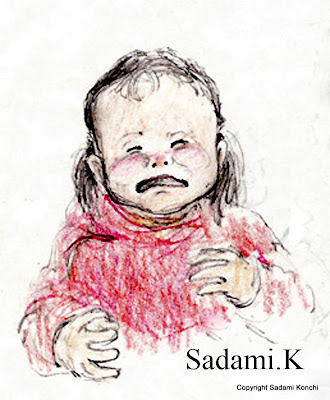
Respect privacy.
If necessary, explain about sketching and get permission first.
Step 3. Get on work.
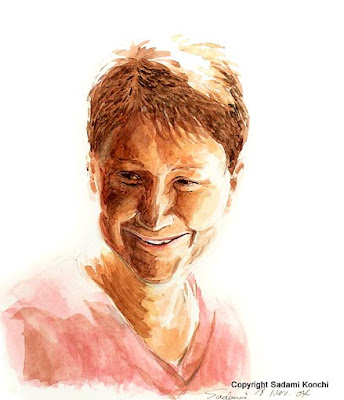 Choose ONE or TWO from these techniques. Line? Value? Colour? What else?
Choose ONE or TWO from these techniques. Line? Value? Colour? What else? With a chosen tool, pin down your first impression or interest on paper.
The work left gave me a hint to catch a face with a loose style.
Technical suggestions are...
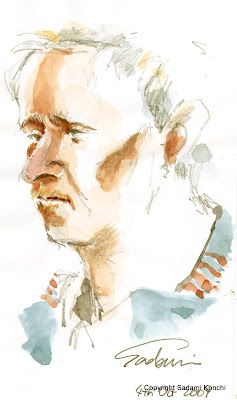 Regarding drawing,
Regarding drawing,1) Define which part of a face shows emotions and tells who s/he is most. Eyes? Mouth? Cheeks? What else? Focus on the marked area.
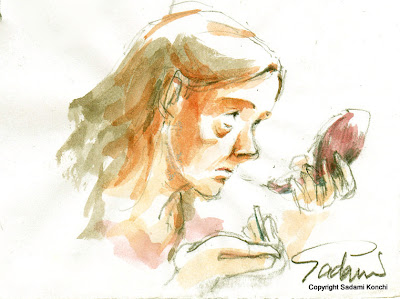
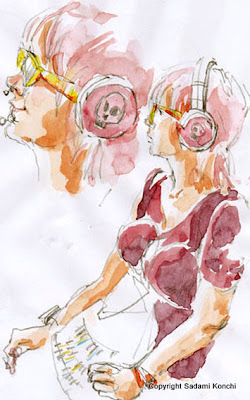
Unique observation is wonderful. Exaggeration is welcome.
Wipe off stereotyped images such as smiling must have such curved lips. Observe a face with fresh eyes full of wonder and awe. I'm still finding so many new things day by day.
2) Make Use of "Settings."
In a face, many other things tell who we are.
Examples. The woman's cosmetics & a compact mirror. The girl's pierces & a mischief headphone. They tell stories. (A4, done in train cart)
Regarding watercolor,
1) Don't look at a tree, but a forest.
Squint eyes. Find the highlight, the darkest, a middle tone and
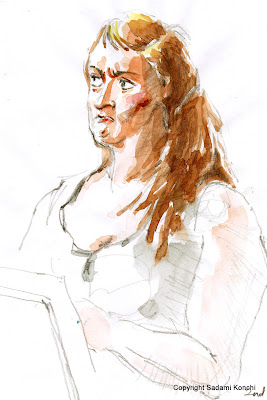 reflection. Capture a face in a big way, not detail.
reflection. Capture a face in a big way, not detail.2) Colour & Value are Close Friends.
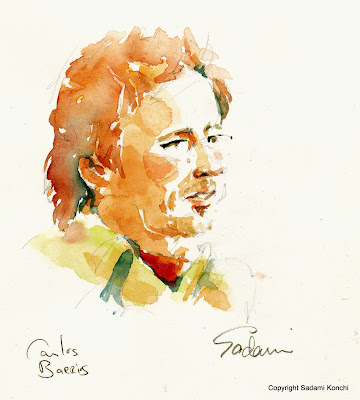 A colour implies a value in a painting. Define which colour comes forward or goes back or stays still in your colour setting. Pull out each color's interesting character and make your own pallet.
A colour implies a value in a painting. Define which colour comes forward or goes back or stays still in your colour setting. Pull out each color's interesting character and make your own pallet. The goal is to express your findings and please yourself, not please others. Keep your first impression whole through the process.
Step 4. Celebrate your work.
Have fun with your model, friends family and with even onlookers. My most privilege is that people love my work.
Unlike a traditional portrait, a quickie needs only a short spare time. Easy for practice. Very simple mathematics. "20 minutes one quickie per day makes 365 practices per year," that improves us. One watercolor or at least one drawing everyday, is my workload and I love it.
BUT please never push yourself too much. If "my setting" 1 try/day is too much, find an enjoyable amount. The point is, don't give up. Continuance is power/strength is true. Just keep up.
Work on your style and enjoy it.
(Part of Portrait. A2)Friends, thank you for sharing time. Next Monday, "body language" will be a topic.
If you would like to know more about how to sketch people, feel free to leave comments and I'll organize a post.Yeah! I'll go for sketching! Lalala~~! Happy painting!


















































